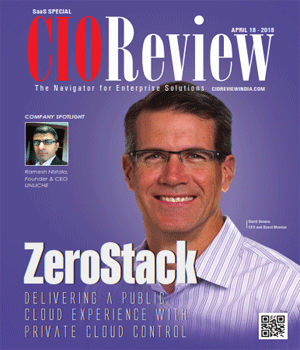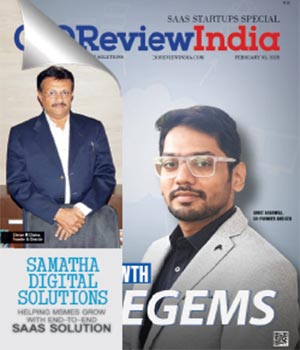
What You Need to Know About AWS
Michael Meyer, Chief Risk Officer and Chief Security Officer, MRS BPO, LLC
 Amazon Web Services (AWS) are becoming an integral part of everyday life in many companies and governments around the world. While everyone has heard of AWS and knows a little about it, there is a lot more to AWS than most of us are aware of. So, we are going to look deeper and explore parts of AWS that you may not be aware of. By the time you finish this article, you will have a good idea of exactly what AWS really is and how it can help your IT department and company’s operations.
Amazon Web Services (AWS) are becoming an integral part of everyday life in many companies and governments around the world. While everyone has heard of AWS and knows a little about it, there is a lot more to AWS than most of us are aware of. So, we are going to look deeper and explore parts of AWS that you may not be aware of. By the time you finish this article, you will have a good idea of exactly what AWS really is and how it can help your IT department and company’s operations.
"Edge Locations are closer to populated areas and basically serve as the front end to AWS"
AWS is not just cloud storage or even a cloud compute engine. AWS is comprised of 90 different types of services in 20 different categories. AWS is growing in size,breadth, and complexity every month. Let’s start with data organization. At a high level, AWS is organized into Regions, Availability Zones, Edge Locations, and Instances. Regions are the highest level and are physical geographic places in the world, whereas Availability Zones are virtual places located within the Regions. Edge Locations are closer to populated areas and basically serve as the front end to AWS, plus cache data to make access faster.
Each user can create one or many instances within an Availability Zone. Each Availability Zone may have one or multiple physical data centers which provide redundancy. As an example, India is in the Asia Pacific (Mumbai) Region (named ap-south-1)which contains two Availability Zones in Mumbai and three edge locations (Mumbai, Chennai, and New Delhi).The entire Asia Pacific Region overall contains 12 total Availability Zones. Across the world, there are 16 different Regions and 44 Availability Zones. AWS has built Regions everywhere around the world except for two continents (Africa and Antarctica). Looking ahead, there are five more Regions and 14 more Availability Zones planned for the 2017 / 2018 timeframe. AWS created Regions to reduce local latency as well as help companies and governments comply with regional rules and data compliance requirements.
Let’s explore some popular services on AWS so that you can speak the language of AWS. First, let’s look at their databases offerings. AWS offers Relational Database Services (RDS) and allows the choice of six different databases (Aurora, MySQL, MariaDB, Oracle, SQL Server, PostgreSQL). AWS also offers several NoSQL database options. Amazon SimpleDB is a straightforward yet powerful database for most quick and needs like logging or monitoring. It is very flexible and forgiving of data structures. Amazon DynamoDB is a very robust NoSQL for most database services. Once you pick the database (SQL or NoSQL) that you want, RDS will automatically install the database, configure it, and perform routine maintenance like installing patches and making backups.
Amazon’s compute engines are well known. The most popular one is Amazon Elastic Compute Cloud (Amazon EC2). This service provides scalable virtual servers for your applications to handle spikes up or down based on your needs (Auto Scaling). There are different computer performance options available labeled C4, M4, T2, I2, and R3. For very extremely intense compute needs, F1 instances are available with Field Programmable Gate Arrays (FPGA’s). Amazon also offers Elastic Load Balancing to help keep each of your EC2 instances from becoming overloaded. For most of us, the easiest and lowest cost way to get started with cloud c omp u t i n g is to use the new Amazon Light sail offering which has most of the options for compute, storage, and networking already pre-configured. This ease of use allows almost anyone (even someone without cloud experience) to launch virtual private servers (VPS) with only a few clicks. It is extremely easy to do in low cost.
Probably one of the most popular services at Amazon is of storage. Their storage services are Amazon Simple Storage Service (S3), Amazon Glacier (for longer term storage) and AWS Storage Gateway which allows you to connect your on-site storage systems to Amazon’s storage systems. As an example of how this works, you could connect Amazon Glacier to your server via the Storage Gateway instead of to a tape backup system. Amazon Elastic Block Storage (EBS) and Amazon Elastic File System (Amazon EFS) provide storage services and are both custom tailored for EC2 instances.
Big Data is something that Amazon does extremely well. Amazon has six major offerings that can help you work with large datasets for analysis and processing. These services are Redshift, Elastic MapReduce (EMR), DynamoDB, Athena,Kinesis, and QuickSight. Redshift is your standard data warehouse but on steroids. It can handle Petabytes of data. Amazon EMR is a managed Hadoop framework that is dynamically scalable.
Athena is a very fast interactive parallel SQL query tool that can be used to get at very large amounts of S3 data in seconds. Kinesis is an interesting tool that allows you t o collect, analyze and process l a r g e amounts of s t reaming data. With this tool, you can now analyze logs, clickstreams and telemetry data in near real-time. QuickSight is an easy to use and low-cost business analytics tool for most companies.
Amazon has many awesome services that are becoming even easier to use, more robust and connected with each other. If you have not started using AWS, or experimenting with it, there hasn’t been a better time to do it than right now.
CIO Viewpoint
Aligning IT Roadmap with Business Objectives: A...
By Subhash singh Punjabi, CISO & Head Enterprise Architecture, Deepak Fertilisers & Petrochemicals Corporation Ltd
Empowering Women: Shaping the Future of Industry
By CIOTechOutlook Team
Scaling AI: Finding the right Biztech...
By Sujatha Gopal, CTO - Communications, Media & Information Services (CMI), Tata Consultancy services
CXO Insights
The Rise Of Developer-LED Innovation And...
By Subrato Bandhu, Regional Vice President, OutSystems
Four Questions To Answer Before Considering A...
By Shrikant Navelkar, Director, Clover Infotech
3 Focus Areas For An Autonomous Driving Revolution











